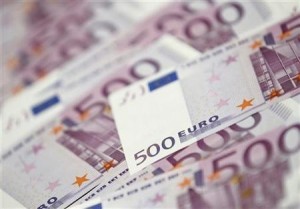 The euro advanced to the strongest level in two weeks against the US dollar as the ECB firmly reiterated its forward guidance in its monthly bulletin, released earlier today.
The euro advanced to the strongest level in two weeks against the US dollar as the ECB firmly reiterated its forward guidance in its monthly bulletin, released earlier today.
EUR/USD touched a two-week high at 1.3686 at 09:50 GMT, after which consolidation followed at 1.3665, surging 0.53% for the day. Support was likely to be received at February 12th low, 1.3562, while resistance was to be met at January 28th high, 1.3688.
In its monthly bulletin released today, the ECB firmly assured that interest rates will be kept at present or even lower levels for a prolonged period of time. The monthly bulletin came in consonance with the main policy statement taken by the central bank President Mario Draghi last week. Mario Draghi left policy on hold, with the benchmark interest rate unchanged at a record low 0.25%.
“The Governing Council firmly reiterates its forward guidance,” the ECB said today, cited by Thomson Reuters. “It continues to expect the key ECB interest rates to remain at present or lower levels for an extended period of time.”
The central bank policy members also said that they expect global inflation to be subdued in the next few months, but also reiterated that the inflation in the euro area is projected to gradually increase towards ECBs target of just below 2%.
The 18-nation common currency came under selling pressure yesterday, following the comments of the ECB Executive Board member, Benoit Coure that the central bank’s policy makers were considering charging banks to deposit spare cash overnight with it. He also added that the ECB does not expect deflation in the euro zone, but a gradual increase to the inflation target of below-but-close-to 2%.
Coeure said in a Thomson Reuters interview: “That is something we are considering very seriously. But you should not expect too much of it,” referring to a negative deposit rate.
The euro was further pressured yesterday, after Eurostat reported that euro zone industrial output declined 0.7% in December, trailing analysts’ projections of a 0.3% drop and after a downward revised 1.6% increase in the previous month. On year-over-year basis, industrial production in the euro area slowed to an annualized 0.5% gain, well below expectations for a 1.8% advance and after a downward revised annualized growth of 2.8% in the preceding month.
The drop in production was mainly driven by a 2.1% slump in production of energy and capital goods, as well as 0.1% decline in output of non-durable goods in December from a month ago.
Mario Draghi tries to guide the euro zone through fragile economic recovery as inflation remains at the lowest since 2009. For now, interventions are postponed at least March, when the central bank is going to publish its quarterly macro-economic forecasts, which will provide first inflation prediction for 2016. Previous forecasts have revealed that the ECB should take more decisive steps and should further ease its monetary policy.
Meanwhile, retail sales index in the United States probably remained flat in January compared to December, according to the median estimate by experts, after a month ago sales rose 0.2%. The Census Bureau is expected to release the official numbers at 13:30 GMT today. Retail sales are closely watched, because they provide crucial information regarding the tendency in consumer spending in the United States, which, on the other hand, accounts for almost two thirds of nation’s Gross Domestic Product. Better than anticipated figures will certainly heighten the appeal of the greenback.
The number of initial jobless claims, an indicator for lay-offs in the country, probably decreased to 330 000 during the week ended on February 8th, from 331 000 in the preceding week. Official figures are to be announced at 13:30 GMT today.
Greenback’s demand was pressured earlier in the week following the new Federal Reserve Chairman Janet Yellen’s remarks that suggested monetary policy is likely to remain loose for a prolonged period of time.
On Tuesday, Janet Yellen told the Republican-controlled House Financial Services Committee, the Fed will “likely reduce the pace of asset purchases in further measured steps at future meetings”, if the labor market continues to recover and inflation rises.
She underscored “continuity” in the Federal reserve monetary policy, emphasizing that she strongly approves the approach of her predecessor, Ben Bernanke.
The current monthly bond-buying program was started in September 2012 and since then the US jobless rate has declined 1.5% to reach a 5-year low at 6.6% in January. However, according to Yellen the rate remains “well above levels” the central bank regards as consistent with maximum sustainable employment.
The Fed Chairman also reiterated that the pace of cutting back Fed stimulus was not on a “preset course”, and added the central bank planned to keep interest rates at zero “well past” the time the jobless rate falls below 6.5%.
The central bank announced its decision to reduce monthly monetary stimulus by 10 billion USD to 65 billion USD at the meeting on policy in January, underscoring that labor market indicators, which “were mixed but on balance showed further improvement”, while nation’s economic growth has “picked up in recent quarters.” Fed policymakers are to hold their next meeting on March 18th-19th.
Elsewhere, GBP/USD touched a session high at 1.6654 at 09:54 GMT, after which consolidation followed at 1.6648, surging 0.31% for the day. Support was likely to be received at February 12th low, 1.6426, while resistance was to be encountered at January 24th high, 1.6668, also the pair’s strongest since May 2nd 2011.





